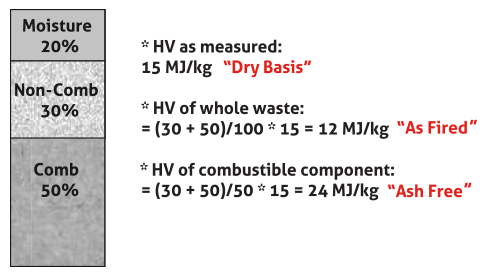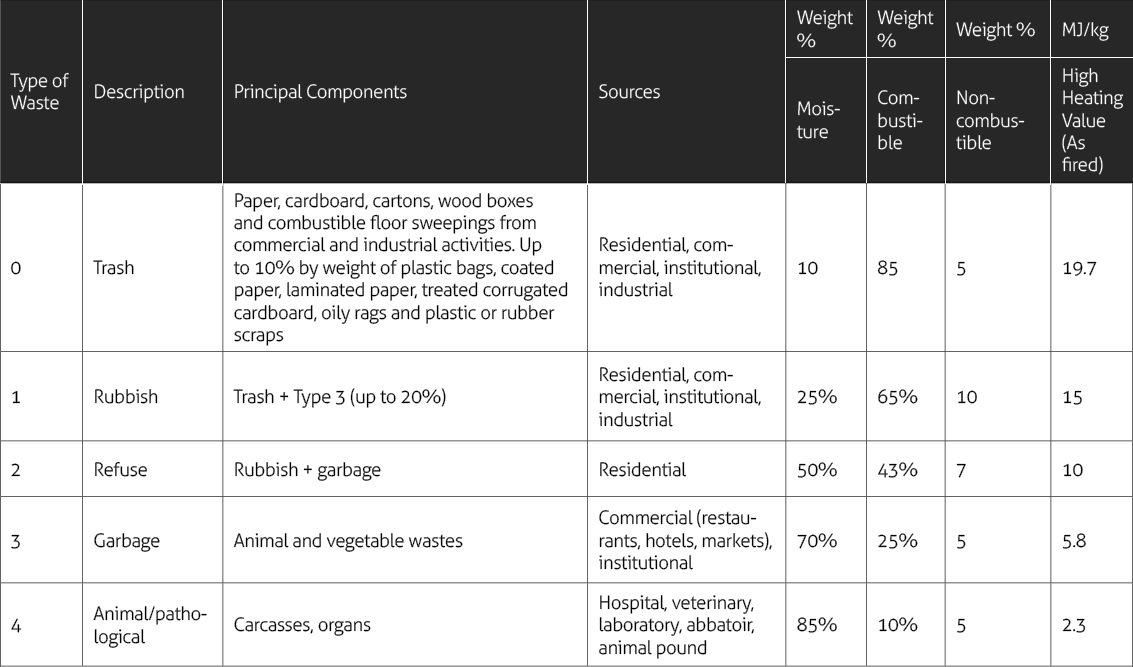Heating value, calorific value and heat of combustion are synonyms that quantify the heat released by the combustible component in the waste. This value is needed to maintain the incinerator’s loading rate at its design capacity. An understanding of the concept can be gained from the hypothetical processes:

Heating values are measured by:
A: Proximate Value: A measured mass of dry waste and a sufficient amount of oxygen, at room temperature, are ignited. The resulting hot flue gas is passed through a heat exchanger, where heat is extracted until the flue gas is brought back to room temperature. Let M be the mass (kg) of the dry waste fed, and H (MJ) the heat extracted from the heat exchanger.
The heating value of the dry waste is H/M (MJ/kg). Below the ignition temperature, combustion does not take place. (Consider, for example, gasoline or wood: it has to be ignited for combustion to take place). For combustion to occur, the temperature in some portion of the matter must be brought up to the ignition temperature. This is referred to as proximate analysis.

B: Elemental Analysis: The Heating Value is calculated from the heat of combustion of the elemental composition (C, H, 0, N, S, Cl …) of the waste.
C: Latent Heat of Evaporation: It influences the heat required to enable combustion to occur. It takes 2.3 MJ (2,200 BTU, 90 cc of propane or 60 cc of diesel) to evaporate 1 L or 1 kg of water.
D: Terminology:
- The term “organic” is used for combustible materials. (Note: this is misleading in that some “inorganic” elements or compounds are combustible, such as carbon, sulphur and carbon monoxide).
- The term “ash” is applied to non-combusted materials. (Note: “inorganic” is also used but this is inaccurate since inorganic also refers to some combustible inorganic compounds).
- Two different heating values are reported in the literature (a) “high” or “gross” and (b) “low” or “net.”
– “High” or “gross” heating value corresponds to the case where the moisture in the flue gas is condensed, and hence the high or gross heating value includes the latent heat of evaporation of the water formed in combustion.
– “Low” or “net” excludes the latent heat evaporation. The low or net heating value thus represents the maximum available energy that can be recovered from the flue gas without condensation.
- The basis on which the heating value is expressed can also be as “fired,” “dry basis” or “ash free.” The distinction is illustrated in the figure below. Note that the different heat value of wastes is a property of the combustible component in the waste. Water (moisture) and the non-combustible components dilute the heating value. In terms of incinerator operation, the relevant basis is “as fired.”
E: Examples
Proximate compositions and heating values of commonly found wastes are given in the below table.

Ketek Cyclonator Incinerators
The Cyclonator range of designs also offer heat-recovery options which can increase your return on investment and reduce your carbon footprint, potentially adding revenue streams to further strengthen your bottom line. Westland has a comprehensive range of technologies available to help capture the heat generated and use it as heat.
